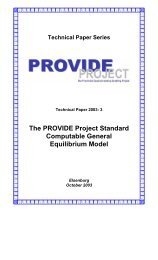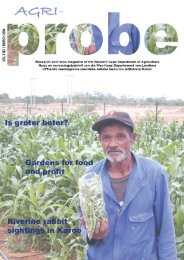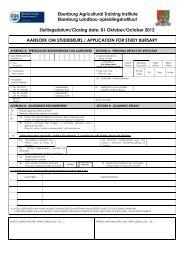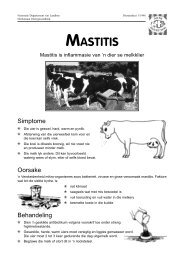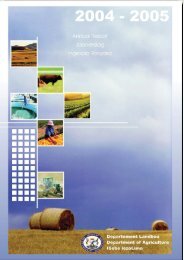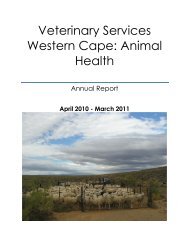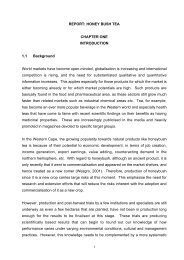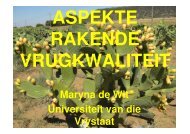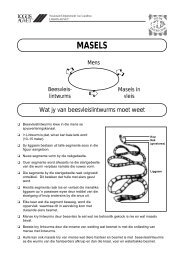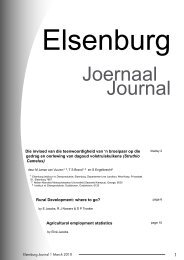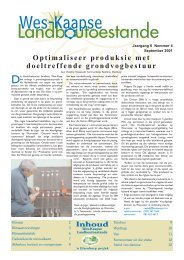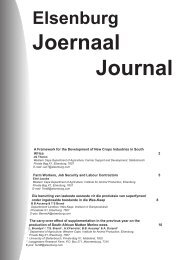Download AgriProbe - Department of Agriculture: Western Cape
Download AgriProbe - Department of Agriculture: Western Cape
Download AgriProbe - Department of Agriculture: Western Cape
Create successful ePaper yourself
Turn your PDF publications into a flip-book with our unique Google optimized e-Paper software.
Ostrich nutrition and<br />
management<br />
17<br />
The ostrich industry is a predominantly South African<br />
industry, which, according to the latest figures provided<br />
by the Ostrich Business Chamber, produces<br />
about 70% <strong>of</strong> all the ostrich products in the world. The<br />
gross value <strong>of</strong> the industry in South Africa is about R 1 200<br />
million per annum, while the feed production industry supplies<br />
feeds to the industry to the value <strong>of</strong> R 600 million per<br />
annum. The ostrich industry is a rapidly growing industry<br />
and markets for leather products with specific qualities are<br />
even extending to the motor industry, while the worldwide<br />
demand for low-fat and low-cholesterol ostrich meat is<br />
ever increasing. However, the industry suffers from a lack<br />
<strong>of</strong> reliable scientific information on the nutritional needs<br />
<strong>of</strong> ostriches, the real nutritive value <strong>of</strong> raw materials for<br />
ostriches as well as reliable nutritional management systems<br />
for ostriches. Variations in feed quality could result<br />
in variations in the quality <strong>of</strong> end products, which could<br />
jeopardise the demand for higher market prices.<br />
Feed prices constitute 70 – 80% <strong>of</strong> the total operational<br />
costs <strong>of</strong> an ostrich production unit, and any increase in reliable<br />
scientific information and management systems will<br />
enhance the pr<strong>of</strong>itability <strong>of</strong> the industry. That alone would<br />
lead to an extension in both the scope <strong>of</strong> opportunities and<br />
the pr<strong>of</strong>itability <strong>of</strong> the industry.<br />
Optimisation growth and feed models have already<br />
been developed overseas, for instance for poultry, turkeys<br />
and pigs, and are used with great success in these<br />
Pr<strong>of</strong> Tertius Brand, Institute for Animal Production<br />
industries all over the world. These models are capable <strong>of</strong><br />
taking into account various biological and animal-related<br />
factors, feed factors and the environment, as well as the<br />
interactions between these factors. A result is then produced<br />
in economic terms, together with a least-cost diet,<br />
to meet the needs <strong>of</strong> the animals at a specific stage to<br />
produce an end product <strong>of</strong> a specific quality as required<br />
by the market at that stage. These techniques will specifically<br />
benefit the ostrich industry, which provides a range<br />
<strong>of</strong> high-quality end products in terms <strong>of</strong> skins with specific<br />
qualities in keeping with market needs, high-priced<br />
cuts <strong>of</strong> meat and feathers (present income ratio <strong>of</strong> about<br />
60:50:10), which will change from time to time in keeping<br />
with market changes.<br />
At present there are no such optimisation models or<br />
feeding systems in the ostrich industry. The end products<br />
<strong>of</strong> the ostrich industry (skins, meat and feathers) are also<br />
different from those in other industries and the same models<br />
cannot be applied. Such technology should, however,<br />
be developed as soon as possible to be applied within the<br />
ostrich industry in order to improve the competitiveness<br />
<strong>of</strong> the ostrich producing and ostrich feed manufacturing<br />
industry.<br />
A savings <strong>of</strong> 10% in feed costs, made possible by the<br />
use <strong>of</strong> an optimisation model and least-cost feed formulation<br />
program with reliable values for feeds, will lead to a<br />
saving <strong>of</strong> more than R55 million per annum for the South<br />
African ostrich industry.<br />
Our research team at the Elsenburg Animal Production<br />
AgriPROBE September 2007



